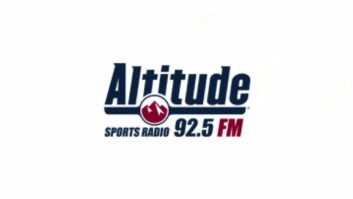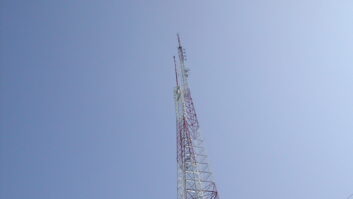KCMG-FM, Los Angeles – AMFM
Jun 1, 2000 12:00 PM, Barry Thomas, CSRE/CBNT
KCMG Equipment List– 360 SystemsDR550-24 Hard Disk Player
– AKG 414B/ULSMicrophone
– AMS Beta Brite Warning message board
– AMS Beta Brite Warning message board-Large
– AMS Beta Brite Warning message board-Small
– AMS Beta Brite Warning message sign
– APC 2000 watt UPS System
– Aphex Compellor 320aAudio Compressor/Limiter
– Audiometrics DA16000A Distribution Amp
– Audion VoxproPS-180C Digital Audio Editor
– Belar RF Amplifier Modulation Monitor
– Belar Stereo Analyzer Modulation Monitor
– Belar Wizard Modulation Monitor
– Broadcast Electronics Audio Vault 100Digital Storage System
– Broadcast Tools ICM-16Controller Intercom
– Carver TX-IITuner
– CircuitWerkes TeleRadio Telephone Listen line
– Comstream AMS1000 Satellite Receiver
– Crown D75 Audio Power Amplifiers
– Custom XLR M/FAES/EBU Termination Block system
– Denon DN-951FA CD Player
– Denon DN-970CD Player
– Digidesign Protools 24/888 Digital Audio Editor
– Digidesign Protools 24/Mix/NTDigital Audio Editor
– DK Audio MSD100 phase display
– Dorrough 1200 Meter
– EAS TFT 911Encoder/Decoder
– Electrovoice RE-27/ND Microphone
– ElectroVoiceRE-20 Microphone
– ESE ES185A Master Clock driver
– Eventide Harmonizer H3000DSP Effects Processor
– Fostex 6301 BEAV Powered Speakers
– Furman PL8 Plus Power conditioner
– GKMFR85.2524222LUC Equipment Rack
– Hafler Pro 3000Audio Power Amplifier
– Henry Matchbox Audio Interfaces
– HHB CDR850CD Recorder
– Innovonics 830 Tuner
– Intraplex TDM-163 T-1 Multiplexer
– JBL Control 1 Speaker
– JBL Control 5 Speaker
– JBL 4412Speaker
– KRK V8Speakers
– Lexicon PCM80Audio Effects Processor
– Mackie HR824Nearfield Monitor Speakers
– Mackie HUI 12Protools Editor Control Surface
– Mackie 1632Audio Mixer
– Marantz CDR620CD Recorder
– Middle Atlantic Furniture
– Middle Atlantic U2 Rack Shelves
– OC-White 3-section Microphone arm
– Omnimount WA100 Speaker Mounts
– Orban 8100A Audio Processor
– Orban 8200A/U3S Audio Processor
– Otari MTR-12 Reel Tape Recorders
– Panasonic SV-4100 DAT Recorders
– Pioneer CDJ-500GCD Players
– PR&E 99154-4Patch Bay
– PR&E 99-388Distribution Amps
– PR&E Furniture
– PR&E Mixer cabinet
– PR&E Molex Termination Block system
– PR&E PMX-28Audio Console
– PR&E Program Switcher
– PR&E Radiomixer 28
– PR&E LS-10 Audio Selector
– QEI Cat-Link T-1 Multiplexer
– Radio Systems AC-12 Analog Slave Clocks
– Radio SystemsAMD-1 Master Clock driver
– Rane Audio equalizer
– SAS 3200Audio Router – Frame
– Seimons 66B 350 Wiring Blocks
– Sine Systems MBC-1/OC-2Warning message controllers
– Sony DAT Recorder
– Soundcraft Spirit 32x8x2 Audio Console
– Symetrix 528E Mic Processors
– Symetrix A420Audio Power Amplifier
– Symetrix SX202 RM Mic Preamp
– Tascam 122MKIII Cassette Recorder
– Tascam 202MKIII Cassette Recorders
– Tascam122 MKII Cassette Recorder
– TC Electronic Finalizer Audio Effects Processor
– TC Electronic M2000 Audio Effects Processor
– Telos 1A2 Interface Telephone Interface
– Telos One Telephone Interface
– Telos One+One Telephone Hybrid
– Telos Switch Console Telephone Consoles
– Telos Zephyr ISDN Codecs
– Telos 100 Delta Telephone Hybrid
– TFT 8300 STL Transmitter
– TFT930 EAS Receiver
– TL Audio2014 Vacuum Tube Microphone Processor
– Wegner Satellite Receiver
– Yamaha NS-10MC Speakers
When AMFM launched Mega 100 (KCMG, Los Angeles) in November 1997, it launched what would become a new radio genre: Jammin Oldies. The goal of the studio project was to create a facility that would reflect the attitude of this new format and serve as a flexible platform to serve other AMFM stations.
Mega 100’s studios reside in a prominent skyscraper in the Mid-Wilshire district of Los Angeles, at the end of Museum Row on the border of Beverly Hills. The studios take up a little more than half of the sixth floor, roughly 10,000 square feet. Building studios in a high-rise presents unique challenges that many stations do not face. Building in a high-rise in L.A. presents challenges few stations ever face. More than $50,000 was spent on floor strengthening alone to support studios that would meet the sound-leakage requirements of adjacent tenants. Conditional-use permits cost $25,000, and almost $15,000 was spent on gaining electrical compliance with Los Angeles UL-listing requirements.
Special attention was paid to the office areas to create an open and relaxed atmosphere. Curved walls and bright, striking colors were used to lessen the feeling of being boxed in that so many high-rise offices suffer from. A 250-gallon salt-water aquarium separates the main lobby from the adjacent main conference room. The aquarium is home to a constantly changing, colorful array of tropical fish with names like Lola the Angel Fish; Snoop-Dog, the Dog-Faced Puffer; Stanley, the Zebra Moray Eel; Spot the Panther Grouper (it’s spotted); and Tiger the Tiger Grouper (it has stripes).

For larger images, click here.
The front lobby.

The air studio.

One production studio.

The hallway.

The rack room.

The facility foor plan.

T he office and workstation layout are arranged so employees are only a step or two away from their supervisors and others with whom they interact. There is even a room called the “Situation Room,” which is used for small, problem-solving conferences away from the distractions of the office or cubicle. The room is also optimized for conference-call situations. The office layout follows a natural progression around the perimeter of the building through sales, operations, promotions, programming, engineering and, finally, the studio suite.
All studios were built on lightweight concrete floors floating on rubber feet. Each studio meets or exceeds an NC-20 rating. The main on-air studio is designed for low-profile equipment placement and open visual angles. All mission-critical controls are within a 45-degree arc at the operator’s position. Control of the Broadcast Electronics AudioVault audio workstations is done using the two flat-screen monitors above the console. The left screen has the music log, audio inventory and displays six decks for audio elements. The right screen displays the semi-automated spot log and controls the single pot for commercial elements. The CD players in the left rack are used for backup audio and special purposes only. Conventional monitor screens to the announcer’s right are used for Internet browsing, e-mail (requests and announcer personal), and telephone screening. The monitor on the left of the operator displays the VoxPro (Mac-based) audio editor and uses the Orb disk system for individual audio storage. Transmitter controls, the EAS terminal, record input selectors and studio switching are housed in the rack immediately behind the operator, beside the still-operating two-track Otari MTR-12 “dust collector.”
There is another studio outfitted with the same equipment that serves as the standby studio should the main studio need service. This room also serves as the studio used by AMFM stations and network syndicators when they visit Los Angeles. This auxiliary studio is also fitted with basic production capability and is used for simple two-track production and announcer show-preparation. The two studios are separated by a news booth, which also serves as the producer for call-screener stations. The news console is also useful for music or spot dubbing into the AudioVault during tight production schedules.
There are two production studios. Production A serves as the primary imaging studio and is the office of Mega 100’s creative services director. This studio is used to create promos, image elements, music specials and other elements for Mega 100 and a host of other AMFM Jammin Oldies stations nationwide. During the overnight and early- morning hours, this studio also serves the John London and the House Party morning show. The morning show production specialist creates promos, parody songs and comedy elements nonstop during the show and builds “best-of” collections for rebroadcast and CD distribution. This studio is built as a merge of broadcast design and pro-audio functionality. To the right of the PR&E ProductionMixer audio console is a separate workstation space for the Protools 24/Macintosh audio editing system. This workstation uses a Mackie HUI interface with Protools and even sports its own near-field monitoring system. The ProductionMixer is flanked with the standard production effects tools, DAT and CD decks, a CD writer and high-quality microphone processing.
Production B faces Production A and the two share a large window. The design is based on a pro-audio concept. This room is the center of Mega 100’s commercial production system and houses the station production director. Along with the SoundCraft audio console and vacuum-tube mic processing, there is a Protools Mix/NT editing system that stands as the room’s centerpiece. All of the furniture in this room is stock Middle-Atlantic edit suite furniture mounted on wheels so it can be moved aside so the room can be used as a vocal studio for Production A.
The studio section, or flight deck, is linked by a hallway that also serves as the central distribution rack. On-air playback, transmitter control, audio routing and station monitoring can all be accessed from this location. The space behind this hallway and the racks is used for the engineering shop, master audio, RF and computer wiring distribution as well as the central-computer data center. The central racks house the SAS 32000 Audio Router, Belar Wizard monitoring system, Orban audio processing, the Intraplex and QEI T1 STL systems (one for each of two transmitter sites), Burk ARC-16 transmitter controls, dial-up and ISDN audio codecs, and satellite receivers. Although this arrangement may seem exposed, little damage that can be done in this space that cannot be done in any of the studios. The separation of the flight deck from the main station offices and various physical protections serve as sufficient isolation to limit access by unauthorized persons.
Sensitive computer functions are restricted to this data center, which also houses all PCs in use in the studios. These computers are controlled using Cybex SNAP KVM (keyboard/video/mouse) extenders and an extensive Cybex 4XP KVM switching system. Access to all critical workstations and servers can be gained from various studios, the data center, and even the technical director’s office. The Cybex switcher is responsible for a massive reduction in computer monitor space requirements and expense.
Rooftop antennas are a particular issue on high-rises but offered a more difficult challenge than most: The roof has no penthouse. The emergency helipad and local resident concerns restricted the height of all antennas and forced some creativity in positioning of satellite antennas. The C-band antenna for Satcom C-5 is nestled in a roof cavity created for the building air condition chillers just above the building’s 24-hour condenser. An easy view of the two transmitter sites at Beverly Hills and Mount Wilson made for a simple microwave shot. Because of frequency congestion, both paths are served by a single transmitter using a power divider that gave much better results than expected.
A 30,000W Kohler Diesel Generator sits on the parking level and shares an exhaust duct with the building’s �MW diesel power plant. Next to it is an air-conditioning condenser unit, which serves as an emergency standby for the computer and engineering space air conditioners. This unit also operates at night to help reduce the station’s dependency on the building’s 24-hour water chiller and ensures its readiness in an emergency.
Because this is L.A., you may be wondering about earthquakes. Like most buildings built since the ’70s, this building sits on rollers that allow the skyscraper to sway and absorb tectonic stresses and earth movement. The building is exceptionally flexible and able to withstand significant motion. Earth movement does require some considerations when mounting equipment. Counter-mounted equipment, and even arm-mounted computer monitors, are quite well-secured by Velcro. Equipment hung from the ceiling requires safety cables wired to structural members.
Note: Jammin Oldies is a registered trademark of AMFM.
Barry Thomas, CSRE/CBNT, was the technical director of KCMG during the studio construction project.












